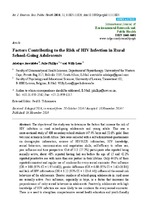| dc.description.abstract | The objective of this study was to determine the factors that increase the risk of HIV infection in rural school-going adolescents and young adults. This was a cross-sectional study of 430 secondary school students (47.4% boys and 52.6% girls) from two rural schools in South Africa. Data were collected with a self-administered questionnaire on demographic information, sources of HIV/AIDS information, HIV knowledge, sexual behaviors, communication and negotiation skills, self-efficacy to refuse sex, peer influence and time perspective. Out of 113 (27.2%) participants who reported being sexually active, about 48% reported having had sex before the age of 15 and 42.2%
reported penetrative sex with more than one partner in their lifetime. Only 44.8% of them reported consistent and regular use of condoms for every sexual encounter. Peer influence (OR = 3.01 (95% CI = 1.97-4.60)), gender difference (OR = 6.60 (95% CI = 1.62-26.84)) and lack of HIV information (OR = 1.22 (95% CI = 1.03-1.44)) influenced the sexual risk behaviors of the adolescents. Greater numbers of school-going adolescents in rural areas are sexually active. Peer influence, especially in boys, is a factor that increases the preponderance of risky sexual behaviors in adolescents. Positively, adolescents with high knowledge of HIV infection are more likely to use condoms for every sexual encounter.
There is a need to strengthen comprehensive sexual health education and youth-friendly HIV prevention strategies to promote abstinence and safe sexual behaviors, especially among boys. | en_US |

